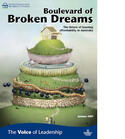In The Communist Manifesto, Marx and Engels warned that the ‘spectre’ of class war loomed over a rapidly industrialising capitalist world. Today, the neoliberal world is increasingly haunted by a similar spectre, this time of a global class conflict. read more »
Australia
Australian Work Access: Not Yet the New Normal
Around the world, the pandemic produced a strong increase in working at home and a reduction in traveling to work in the last few years. Even as lockdowns have generally been removed or relaxed, the share of the remote work force has greatly increased from previous norms. read more »
- Login to post comments
Migratory Millennials - Marching from the Metropolis
As stories of new migration patterns and movement across Australia’s cities and regions abound, updated population data shows that what initially appeared to be a pandemic-induced blip is instead the beginning of a reversal of a long-term trend. read more »
- Login to post comments
Australia Votes - and a New Political Geography Emerges
The May 21 Federal Election in Australia saw the sitting conservative party (the Liberals) ousted from office, and the left-wing opposition Australian Labor Party claiming victory. read more »
- Login to post comments
For Texans and Australians It's Breezes and Sunshine, Or No Grid At All
The Texans’ Electric Reliability Council of Texas (ERCOT), and Australians are constantly being blown away with the growing “nameplate” capacity of wind turbines and solar panels to provide electricity, but electricity from renewables have yet to produce anywhere near their projected capacity due to the intermittency and unreliability of breezes and sunshine. read more »
- Login to post comments
Demographia International Housing Affordability – 2022 Edition Released
Demographia International Housing Affordability rates middle-income housing affordability in 92 major housing markets in eight nations: Australia, Canada, China, Ireland, New Zealand, Singapore, the United Kingdom and the United States). read more »
- Login to post comments
Is Suburbia’s Global Benchmark Share of Urban Jobs 87%?
“The great enemy of truth is very often not the lie--deliberate, contrived and dishonest--but the myth--persistent, persuasive, and unrealistic. Too often we hold fast to the cliches of our forebears. We subject all facts to a prefabricated set of interpretations. We enjoy the comfort of opinion without the discomfort of thought.” read more »
A Long Term Outlook on Housing Affordability
So, there’s yet another inquiry into housing affordability underway. This latest is called “The House of Representatives Standing Committee on Tax and Revenue inquiry into housing affordability and supply in Australia.” Chaired by NSW Liberal MP Mr Jason Falinski, it’s getting a few headlines with statements like ‘half the cost of new house and land packages consist of state and local government charges.’ read more »
- Login to post comments
Reply to Elizabeth Farrelly: Suburbia Not Kulturstadt
Recently on Twitter I came across a post about the NSW Panning Minister's announcement banning dark roofing for detached houses in fringe housing estates to minimise the heat island effect. Scrolling down the comments, I noticed one by the Sydney Morning Herald’s anti-suburban architecture critic, Elizabeth Farrelly. read more »
- Login to post comments
A COVID Postcard from Australia
Australia’s response to Covid-19 has quickly turned from laudable to laughable. For a nation which only a few months ago seemed to be the toast of world leaders for having so effectively limited the spread of the virus and still growing its economy, to a nation now lagging on vaccination and struggling with lockdowns, the turnaround has been dramatic. read more »
- Login to post comments






















